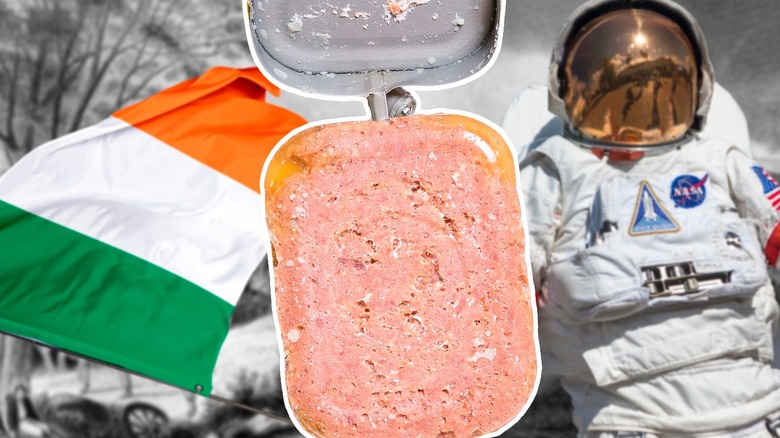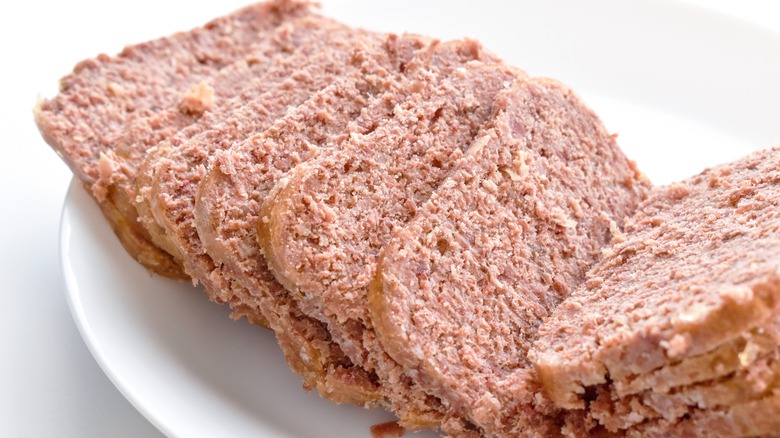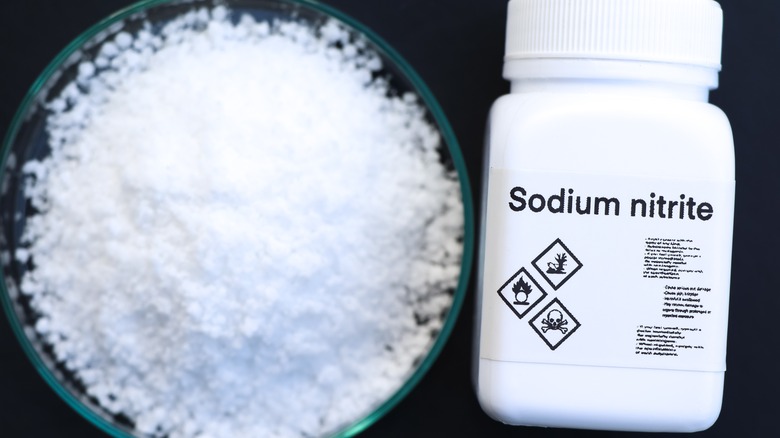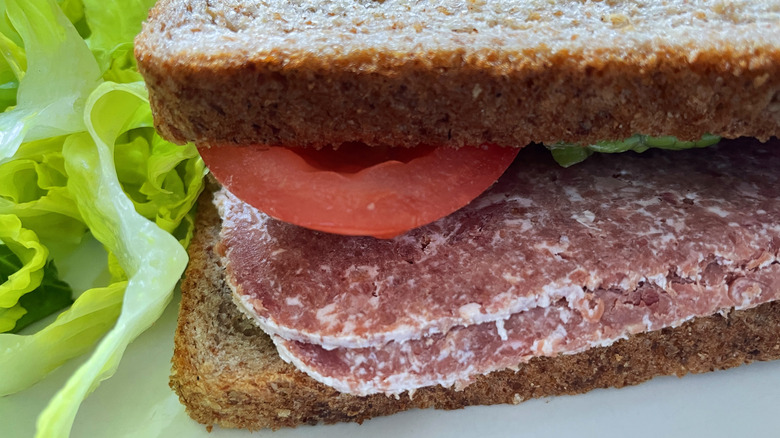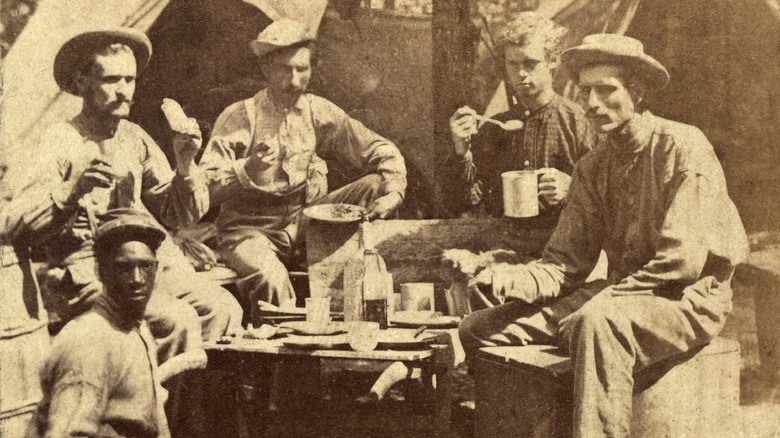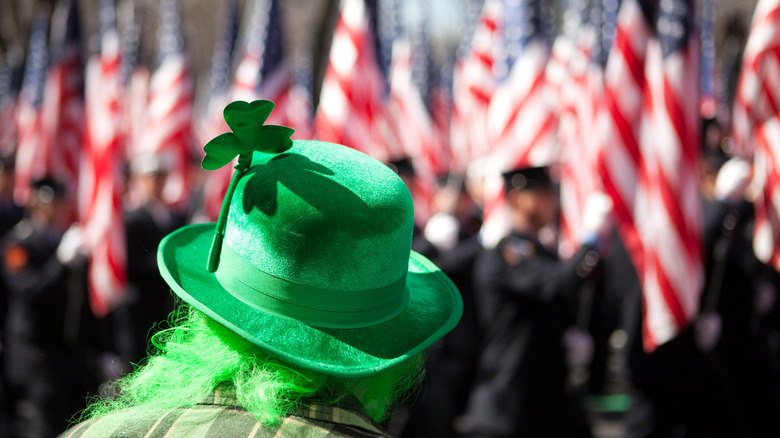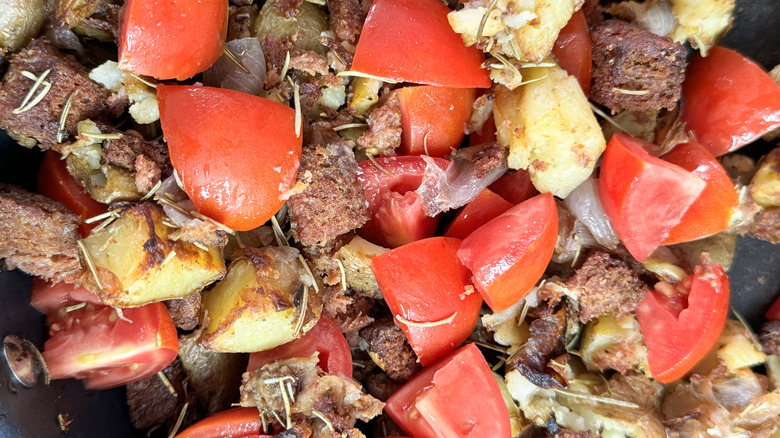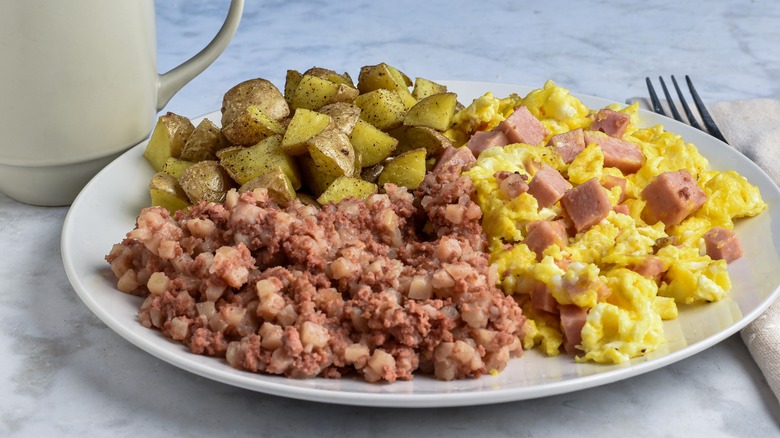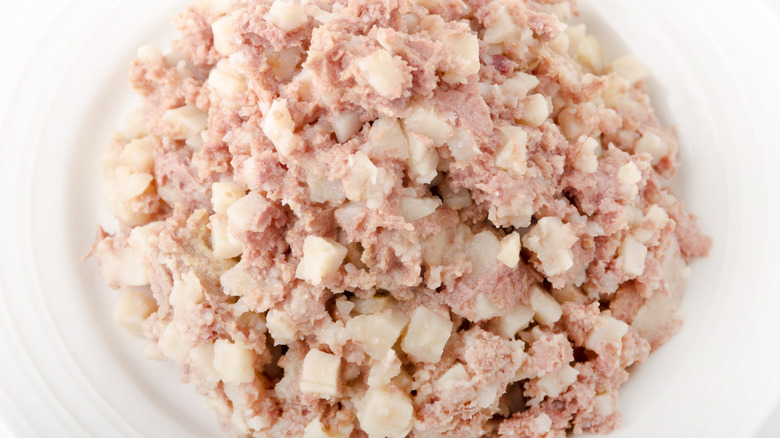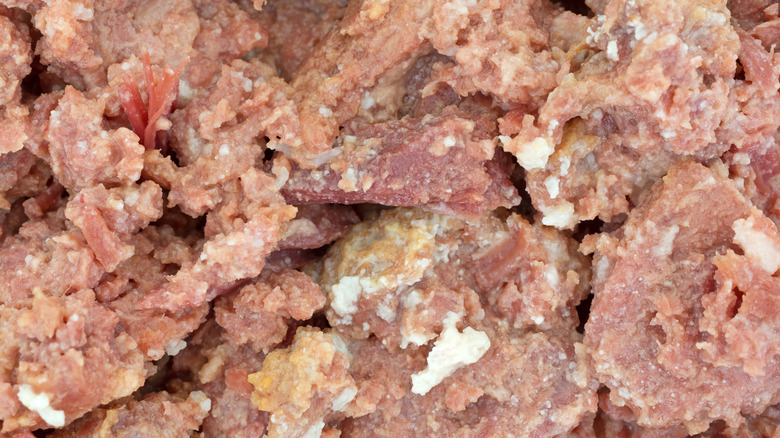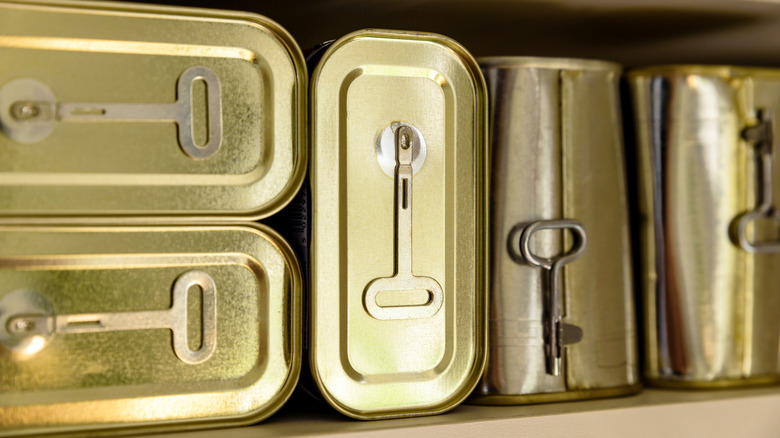11 Myths About Canned Corned Beef You Need To Stop Believing
"The Scarlet Letter" author Nathaniel Hawthorne had a pretty glum view of the human condition; however, he did have a soft spot for corned beef. With a sniff of pride for his own "skillful cookery," Hawthorne declared corned beef "as such a masterpiece in its way that it seems irreverential to eat it."
Though, Hawthorne might have had less kind words about canned corned beef. Alas, canned corned beef is a bit of a conundrum for the modern chef. Some have called it one of the worst canned foods you can buy, and it won an unpopularity contest in 2022 as the canned food that most Tasting Table readers would never buy. On the other hand, fans of the product insist that it has a place in the pantry and that it's simply misunderstood due to common mistakes made with canned corned beef in the kitchen.
It came into being largely as a European army ration, and this history has weighed down the dish with plenty of myths and urban legends. While there's a kernel of truth in any tall tale, it's high time to can some of these for good. So, here's the beef on canned corned beef.
1. Canned corned beef is too salty
In 1902, Edward Lyman Munson published "The Theory and Practice of Military Hygiene," detailing how American troops encountered a foe equally as dangerous as anyone they fought on the battlefields: canned corned beef. "Condemned" as a daily ration, an excerpt from the book noted, "Canned corned beef is very salty and soon becomes distasteful." No doubt, anyone who has tried the canned meat might be overpowered by the ultra-high sodium content.
While it definitely has a lot of salt, modern-day cooks have the choice of buying the low-sodium variety. Many brands offer versions of canned corned beef that can range up to 25% less sodium, with no effort needed on your part.
If your store doesn't offer low-sodium canned corned beef, there are some DIY options on the table. You can soak or rinse and boil your canned corned beef in water to draw out the sodium prior to cooking. If you have corned beef hash and water isn't really doable, simply add some sugar to balance out the salt. Please note that the last method reduces the salty flavor, not the actual sodium content, and adding sugar will amp up the carb calories.
If canned corned beef is one of many ingredients in a dish, you can balance the salty taste by adding different sauces and seasonings. Mixing in vegetables can also soak up excess sodium and bring your canned corned beef down a notch.
2. Preservatives in canned corned beef can make it last forever
In a silly public service announcement for the inevitable zombie apocalypse, PBS announced that canned meat was essential for anyone trying to out-hide or out-run hordes of the undead. (Tip: Bring a can opener). The reason? Canned foods are usually vacuum-packed and typically have preservatives that make them last longer. Manufacturer Hormel advised in the past that its canned products can last indefinitely if sealed and undamaged, Hormel has changed its recommendation since then.
Today, Hormel states that its canned foods should only be enjoyed by their "best by" dates, even during a zombie invasion. Though shelf life can vary, regular supermarket brands generally don't extend canned goods too far into the future. Healthline reports that most canned corned beef contains sodium nitrite, a preservative and salt additive contributing to the high sodium. As a preservative, it prevents bacteria from forming while adding some flavor and longevity to the meats.
However, for the apocalypse, consider this: Military-grade canned corned beef rations are freeze-dried and can be stored in your private bunker for over 25 years.
3. There's corn in canned corned beef
When given a can and asked, "Where's the beef?", we can pretty much just open it up and gaze inside. But the "corned" part of corned beef is a bit trickier to discern. The casual diner might assume there's a byproduct of a cob mixed in somehow. Maybe the cows had a corn-based diet?
Alas, anyone hopeful that corned beef was really disguised grain-fed wagyu should know that the corn actually comes into play during the prep process. Corned beef got its name from the various curing salts that the butcher used to preserve the meat. Back in the old days, "corn" was associated with any small granule that stemmed from a seed or grain crop, like oats or wheat. Due to their similar size, large "kernels" of salt crystals were also called "corn." The salts were mixed into the brine, which not only gave the meat a salty taste but helped to keep it safe for storage and later consumption. The name stuck.
Incidentally, when gazing at that opened can of corned beef, you'll spot plenty of white gelatinous substance along the sides and throughout the meat. The white particles might look like leftover salt, but it actually isn't the "corn," either. It's a mixture of fat, water, and collagen that solidified during the canning process. Sure, you'll taste the salty corn for sure, but it's all beef.
4. Canned corned beef originated in the Civil War
Canned foods have been part of army rations for centuries, and it's often thought that canned corned beef dates back to the time of the Civil War. In 1862, a report for the Quartermaster Research and Engineering Command, U.S. Army looked at the logistics of salted meat versus fresh meat. While fresh beef was certainly preferred over canned goods, the prospect of sending a 1,500-pound cow across the country to feed the Army of the Potomac was a nightmare.
The answer was in the can. The report found that an 8-ounce can of corned meat was equal to about 20 ounces of fresh beef. Canned foods were so efficient and convenient that after the Civil War, canned rations became popularized among the public. In fact, Libby's canned corned beef became a hit a mere five years after the Civil War.
But canned corned beef actually predates the Civil War by quite a few decades, and it didn't originate in the U.S. As early as 1810, Nicolas Appert, a French chef and distiller, published "L'art de Conserver, Pendant Plusieurs Années, Toutes les Substances Animales et Végétales", where he described his process for canning and preserving meats and veggies. By 1819, the process for preserving roast beef was patented: The roast beef was cooked to 203 degrees F, placed in cans, and then sealed and submerged in boiling brine or superheated steam.
5. Canned corned beef is exclusively an Irish dish
Corned beef is usually associated with cabbage, and if you're lucky, a pot of gold on March 17. The day to wear green marks a celebration in Ireland, and corned beef is a St. Patrick's Day staple, partially due to its historic popularity with the Irish American community. It makes sense that the canned corned beef is a fan favorite among the Irish.
But it turns out that it also has a place in other international cuisines. Jewish delis, especially in New York, had long carried corned beef, which helped popularize the dish among Irish Americans in the early 20th century, according to The Nosher. As cookbook author Jake Cohen explained, corned beef — whether in cans, the deli, or the butcher — is a "Jew-ish" recipe.
Canned corned beef also made its way 'round the world, mostly through army knapsacks. European colonies in the Caribbean and Southeast Asia helped make canned corned beef a central part of many diets. Down south in Jamaica, canned corned beef, known as bully beef, is key to many flavorful Jamaican dishes, while in the Philippines, pandesal pastries are one of many Filipino dishes with Hispanic influences and are often stuffed with corned beef.
6. Canned corned beef is inferior to fresh corned beef
"We may find in the long run that tinned food is a deadlier weapon than the machine gun," writer George Orwell penned in "The Road to Wigan Pier."
Now, it's not quite as bad as that. In terms of nutrition, canned food doesn't contain fewer vitamins than fresh foods and can even have more, according to the United States Department of Agriculture (USDA).
Admittedly, canned corned beef might be an unattractive main dish, but it has plenty of advantages over fresh corned beef. One benefit of canned corned beef is that it's a team player in most recipes. Whether you're prepping omelets, tacos, pizzas, fried rice, or even sushi, canned corned beef can be easily mixed in to provide a salty umami topping or filling alongside the cheeses, veggies, and other seasonings.
Orwell had society pegged in many ways but missed the mark for canned corned beef. It might make for a disappointing standalone meal, but canned corned beef is an excellent ready-made ingredient for home-cooked meals.
7. Canned corned beef is basically Spam
The lingering question mark behind the meaning of Spam evokes memories of the infamous "mystery meat" at school cafeterias, and the abbreviation might conjure the thought of unwanted junk emails rather than a distinct meaty aroma. In fact, it might even seem like Spam is canned corned beef under a bold marketing move: The products are both pink, moist with brine, and one solid block of indiscernible, processed meat.
But there are actually many differences between Spam and corned beef. First, we know that canned corned beef is, well, beef, even if there's no corn from the cob. Spam is pork shoulder mixed with ham, seasonings, water, and potato starch. The potato starch is crucial; it binds the minced pork meat into one gelatinous mass. In contrast, canned corned beef is usually one single cut of meat.
Spam is prepped differently than canned corned beef. Corned beef is cured and cooked before it's canned, while Spam is actually cooked within its can. Canned corned beef has a distinct taste, while Spam can come in a variety of flavors that you might not expect, like hickory smoke and maple. In fact, taste tests have shown that adding different meat, like chicken and turkey, changes Spam's taste and texture entirely, which can't really be said for canned corned beef.
And don't forget: Each canned meat is an adaptable ingredient to any recipe, limited only by our creativity and taste buds.
8. Canned corned beef hash is just mashed up corned beef
Sometimes, one word makes all the difference in the world. Case in point: Anyone who has rushed through a grocery aisle and grabbed the first can of corned beef they saw might have been in for a mild surprise when they popped the can open and found out they bought corned beef instead of corned beef hash.
It might seem simple to make hash out of corned beef, to just grab a meat mallet and pound away. But corned beef hash is a bit more complex than mashing up a block of meat. Corned beef hash has additives, such as potato bits, onions, and extra seasoning not found in regular canned corned beef.
The added ingredients in corned beef hash also change the nutrients and calorie counts. According to Fat Secret, a canned corned beef hash can yield 361 calories in a 1-cup serving, with 22.53 grams of fat, 70 milligrams of cholesterol, and because of the potatoes and onions, 2.4 grams of fiber. However, a can of Libby's canned corned beef has no fiber, with more calories, fat, and cholesterol per 1-cup serving. Depending on your dietary needs, either canned corned beef or the hash version may be preferable over the other.
9. Canned corned beef isn't nutritious
A glance at the nutrition label on any canned corned beef might make your heart flutter. According to Nutrition Value, a typical can of corned beef yields quite a bit of fat, cholesterol, and sodium, all of which you can pretty much taste straight out of the can. Don't forget to factor in the preservatives commonly found in canned foods.
While canned corned beef does have considerable fat and sodium content, it also contains plenty of nutrients to balance out your diet. The Food and Agriculture Organization of the United Nations' standard for canned corned beef specifies a minimum protein count to ensure its nutritional value. In addition, among the other vitamins and minerals listed in Nutrition Value's label are high concentrations of iron, potassium, and B12.
To combat the fat and cholesterol, simply remove some of the white fat solids dotted throughout the meat prior to cooking. Or, if browning or sautéing the corned beef, drain some of the oil to lower the calorie levels.
10. All canned corned beef originates from South America
After World War I, the American canning industry pretty much gave up on manufacturing canned corned beef in the U.S. One congressional report from 1964 noted that the domestic demand for canned corned beef was so small that by the 1920s, most companies simply opted to import the stuff. The sole exception was for government orders, usually for army rations.
So, where does most canned corned beef come from? The obvious answer is South America, especially Brazil. Brazil has a strong cattle industry, with an abundance of land devoted to grazing and beef production. Many canning companies source beef from Brazil, including Libby's, Hereford, and Hormel.
But that doesn't mean Brazil has the canned corned beef market cornered. As noted earlier, canned corned beef is part of global cuisine, and many regions offer their own variations. Ox & Palm canned corned beef comes from grass-fed Australian cattle, while Palm comes from next door in New Zealand. Further north, Nozaki canned corned beef is trending in Japan at elite prices. Even Sherlock Holmes will have a hard time digesting this: Argentina Corned Beef, headquartered in the Philippines, is actually made in the U.S. So, browsing through the canned corned beef section at your local grocer is akin to a cattle world tour.
11. Canned corned beef is official NASA space food
The idea of canned corned beef as the ideal food ration didn't just stay on the ground in army bases or pantries. It took off into the wild blue yonder and final frontier. In 1931, aviator Charles Lindbergh and his wife embarked on an aerial globetrotting expedition into Asia and packed up to 45 pounds of emergency rations, including one single can of Swift's corned beef. Luckily, the couple's trip went without a hitch, and the canned corned beef now has a home as an American treasure in the Smithsonian.
It wasn't rocket science for canned corned beef to head into space. Well, kind of. When Gemini III launched into space in 1965, this small step for humanity was accompanied by a giant leap for the beef industry. Astronaut John Young smuggled a deli corned beef sandwich to share with his fellow astronaut Gus Grissom until they realized breadcrumbs were floating around, which could be a safety threat during spaceflight. In his autobiography, Young recalled how congressmen went into an uproar over how NASA's $30 million expenditure into space food research was blown, and NASA took steps to "prevent recurrence of corned beef sandwiches in future flights."
NASA has made good on its promise. The agency's current menu for missions up in zero gravity includes some canned foods — though in the process of phasing out in favor of rehydratable, lightweight pouches — and beef, but, alas, no canned corned beef.
